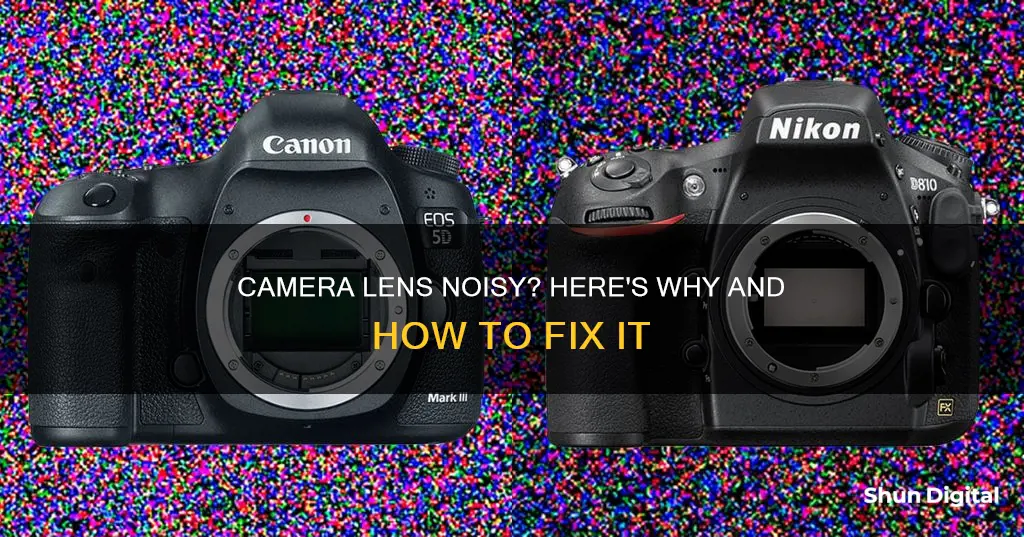
There are many reasons why your camera lens might be making loud noises. It could be due to dirt, sand, or grime in the lens assembly, or damage to the lens or body caused by improper mounting or dropping. In some cases, the image stabilization system or the focus motor and gearing may be the source of the noise. Additionally, the lens type and camera model can also contribute to the noise level during autofocus.
| Characteristics | Values |
|---|---|
| Cause of loud noise | Dirt, sand, or grime in the lens assembly |
| Image stabilization system | |
| Dropping the camera | |
| Improperly mounting the lens | |
| Dust in the lens | |
| Stabilization feature | |
| Plastic gears inside the lens | |
| OIS movement |
What You'll Learn

Dirt, sand, or grime in the lens assembly
If your camera lens is loud, it could be caused by dirt, sand, or grime in the lens assembly. This can result in a loud, scratchy noise when the lens is zooming in or out. To fix this, you will need to clean or replace the lens assembly. Here are some steps you can take to address this issue:
Inspect the Lens Assembly
Before attempting any cleaning or repair work, carefully inspect the lens assembly for any visible signs of dirt, sand, or grime buildup. Look for any gaps or crevices where debris might be lodged. This will help you pinpoint the areas that require cleaning.
Use a Hurricane Blower
A hurricane blower can be used to blast air into the recesses of your camera, dislodging and removing specks of dirt, sand, or grime. Pay close attention to the filter ring and any other areas where debris might be trapped. The Giottos Rocket is a popular option for a hurricane blower, but there are also less costly models available.
Clean with a Microfiber Cloth
After blowing out the lens assembly, use a microfiber cloth to gently wipe away any remaining dirt or grime. Start from the middle of the lens and work outwards, ensuring that you move any dirt away from the central 'sweet spot'. Avoid rubbing too hard, and use gentle circular motions.
Address Stubborn Dirt or Fingerprints
For dried-on dirt or stubborn fingerprints, you can try using your breath to create condensation on the lens. This added moisture can help to loosen and remove any remaining spots with a gentle rub. Alternatively, you can use lens-cleaning solutions or a homemade mixture of isopropyl alcohol and distilled water. Apply the liquid to a microfiber cloth or soft tissue before wiping the lens.
Consider Professional Cleaning
If the above steps do not resolve the issue, you may need to seek professional help. Camera lenses are delicate, and improper cleaning techniques can cause damage. Professionals will have the expertise and tools to thoroughly clean or repair your lens assembly without causing further issues.
Motorized Telescoping Lenses: Are They Reliable Camera Companions?
You may want to see also

Image stabilisation system
Image stabilization (IS) is a feature that helps reduce blurring caused by camera shake during exposure. It is particularly useful when shooting in low light, using long shutter speeds, or capturing fast-paced scenes. This technology is especially beneficial for action and sports photography, as it helps produce smoother and clearer footage.
There are two main types of image stabilization: Optical Image Stabilization (OIS) and Electronic Image Stabilization (EIS). OIS involves physically moving elements within the camera lens or sensor to counteract detected motion, and it is highly effective for still photography, especially in low-light conditions. On the other hand, EIS digitally adjusts the image to compensate for motion, often by cropping the edges of the video. This method is commonly used in action cameras and video recording to reduce shakiness when shooting handheld.
Image stabilization systems can be lens-based or found in the camera body. Lens stabilization works by moving the glass elements within the lens to counteract camera movement. Sensors inside the lens detect how the camera is moving and adjust the elements accordingly. This feature is particularly useful when using a DSLR that does not have built-in stabilization. However, lens stabilization can make the lens more expensive.
In-body Image Stabilization (IBIS) moves the sensor along various axes to compensate for camera movement. It is effective for both video and photography and typically offers around 5 stops of stabilization. IBIS has the advantage of working with any lens, including old manual lenses and DSLR lenses mounted on mirrorless cameras. Additionally, it allows for simpler and potentially lighter lens designs since stabilization gadgetry does not need to be incorporated into the lens.
While image stabilization is beneficial, it has some drawbacks. It may not completely eliminate blur in extremely low-light conditions, and EIS can result in a slightly narrower field of view and decreased image quality due to cropping. Additionally, cameras with advanced image stabilization systems tend to be more expensive.
Understanding Camera Lenses: Focal Length Explained
You may want to see also

Faulty focus motor or gearing
A loud camera lens can be caused by a faulty focus motor or gearing. This can happen when the lens is dropped or knocked, causing something to become misaligned or damaged in the focus motor or gearing.
Some signs of a faulty focus motor or gearing include strange noises, such as creaking, clicking, or grinding sounds, as well as autofocus issues like slow or inconsistent autofocus, or erratic autofocus behaviour.
If you suspect that your lens's focus motor or gearing is faulty, it is recommended to have it checked by a professional or the manufacturer. They will be able to diagnose the issue and determine if the lens needs to be repaired or replaced.
It is important to note that attempting to repair a lens yourself can be challenging and may void your warranty. However, if you feel confident in your abilities, you can try cleaning the lens or adjusting the focus ring. If the issue is with the focus motor, it may be necessary to replace it.
In some cases, it may be more cost-effective to replace the lens rather than repair it, especially if it is an older model or the damage is severe. When deciding whether to repair or replace, consider factors such as the cost of repair, the age and condition of the lens, and the severity of the issue.
Best Cameras Compatible with Minolta Lenses
You may want to see also

Damaged plastic gears inside the lens
If your camera lens is making loud noises, it could be due to damaged plastic gears inside the lens. This can happen if the camera has been dropped or knocked, causing something to get knocked out of alignment. If you're handy, you can try to open up the lens to see if there's any damage and if it's something you can fix yourself.
Before attempting any repairs, make sure you have the right tools and materials. You'll need a plastic steel epoxy, a Popsicle stick, a mixing medium for your epoxy mixture, a brush, and some detergent soap or dishwashing liquid. Follow these steps to repair the damaged plastic gears:
- Clean the gear: Ensure that the gear is free from oil and dust by using a brush and detergent soap or dishwashing liquid to clean it.
- Mix the epoxy: Combine the two epoxy compounds and apply them to the broken area of the gear.
- Monitor the epoxy: As the epoxy is not yet fully hardened, keep an eye on it to prevent it from sticking to one area of the gear.
- Mould the teeth: After about an hour, the epoxy will start to harden. Position the new mould gear in place and slowly rotate it to adapt the teeth of the gear. You may need to apply some grease to the gear to prevent the epoxy from sticking.
- Cure the gear: Remove the gear from the gearbox assembly and place it in a well-ventilated area for a day to fully cure.
- Reinstall the gear: Once the epoxy is completely hardened, install the gear back into the gearbox and assemble the parts.
It's important to note that attempting to repair your camera lens may void its warranty. If you're unsure about the process or don't feel comfortable doing it yourself, it's best to consult a professional or contact the manufacturer for support.
Pentax Lenses: Will They Fit Your New Camera?
You may want to see also

Faulty image stabilisation
Image stabilisation is a common feature in modern camera lenses, and it often involves the use of gyroscopes or other mechanisms to compensate for camera shake and movement. This helps to produce sharper images, especially in low-light conditions or when using slower shutter speeds. However, sometimes, the image stabilisation system can develop faults, which can result in unusual noises coming from the lens.
One possible cause of a loud camera lens is a faulty image stabilisation system. This can occur when the image stabilisation mechanism becomes misaligned or damaged. In some cases, it may be due to dirt, sand, or grime in the lens assembly. It is also possible for the image stabilisation system to become activated accidentally, causing it to make noise even when it is not needed. This can be confirmed by disabling the image stabilisation feature in the camera settings. If the noise persists, it may be necessary to clean or replace the lens assembly.
The image stabilisation system in a camera lens typically uses gyroscopes or other motion sensors to detect camera shake and adjust the lens elements accordingly. This process can create a quiet whirring or buzzing sound, which is usually soft and unnoticeable in most environments. However, if the image stabilisation system is faulty or damaged, it can produce louder or more unusual noises. In some cases, the noise may be described as a grinding, grating, or scratching sound.
In some cases, the noise from the image stabilisation system may be due to a malfunction in the feedback control system. This system is responsible for continuously adjusting the lens elements to compensate for camera shake. If the feedback control system is not functioning properly, it can cause the lens elements to move in an irregular or unpredictable manner, resulting in unusual noises. Additionally, the image stabilisation system may produce a louder noise when the lens is set to a longer focal length, as this requires more movement of the lens elements to stabilise the image.
It is important to note that the noise from a faulty image stabilisation system may not affect the image quality or the functionality of the lens. However, if the noise is bothersome or interferes with the use of the camera, it may be necessary to have the lens serviced or repaired by a professional. In some cases, it may be more cost-effective to replace the lens, especially if it is an older model or if the damage is extensive.
Trade-In Camera Lenses: Best Places for Your Old Gear
You may want to see also
Frequently asked questions
This could be due to a few reasons. Firstly, it could be an issue with the image stabilisation system, which sometimes produces a grinding sound. It could also be caused by dirt, sand or grime in the lens assembly, which will need to be cleaned or replaced.
The fall might have knocked something out of alignment in the focus motor or gearing, which will likely get worse with continued use. It could also be that something is obstructing the plastic gears inside the lens.
It's possible that dust has gotten behind the lens, or that you've accidentally switched on the stabilisation feature, which has a louder motor.
The noise level depends on the lens. Try using a lens with a STM or other silent focusing motor, or focus manually. You can also use an off-camera mic to reduce the noise picked up by your audio.







